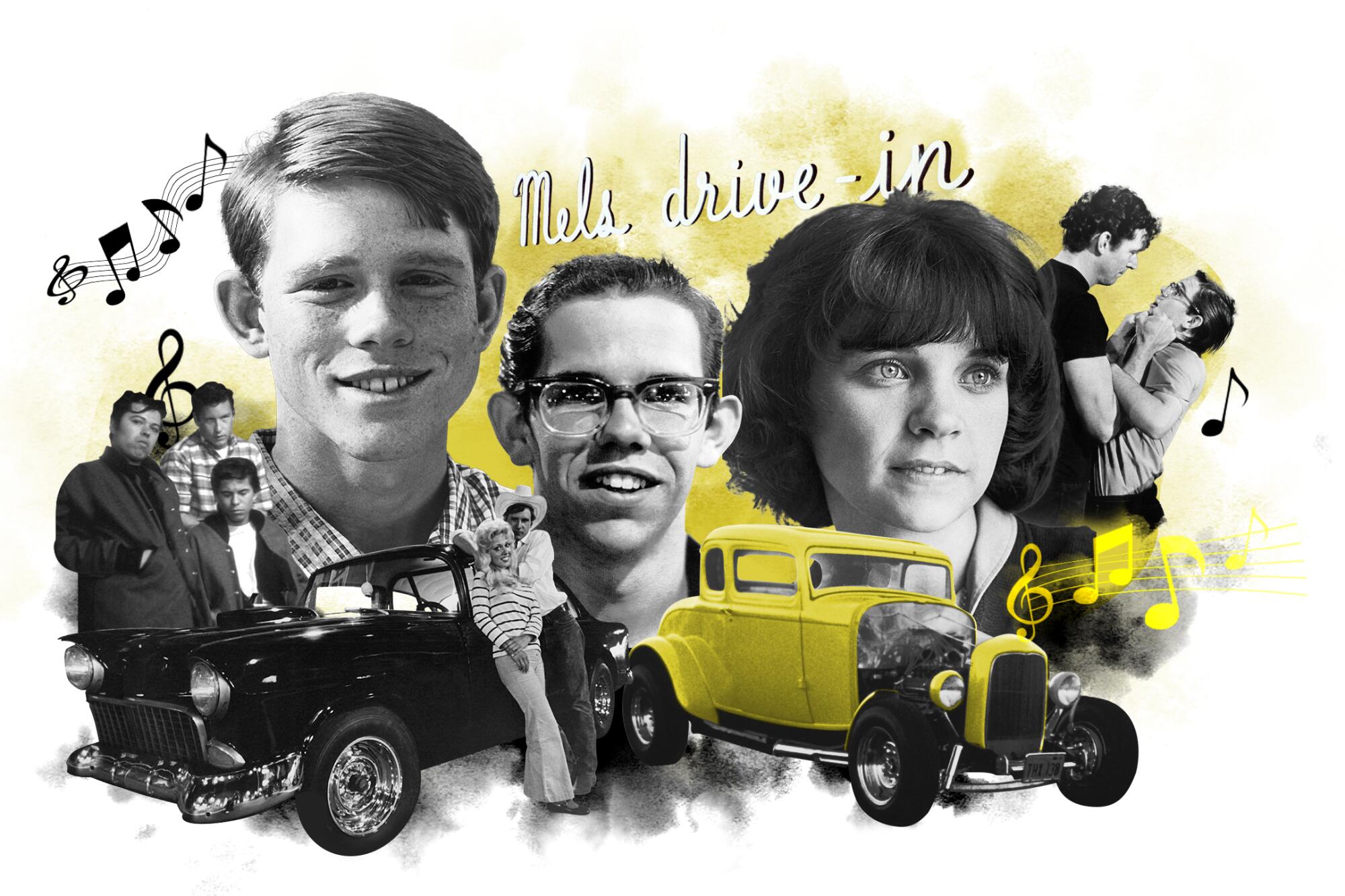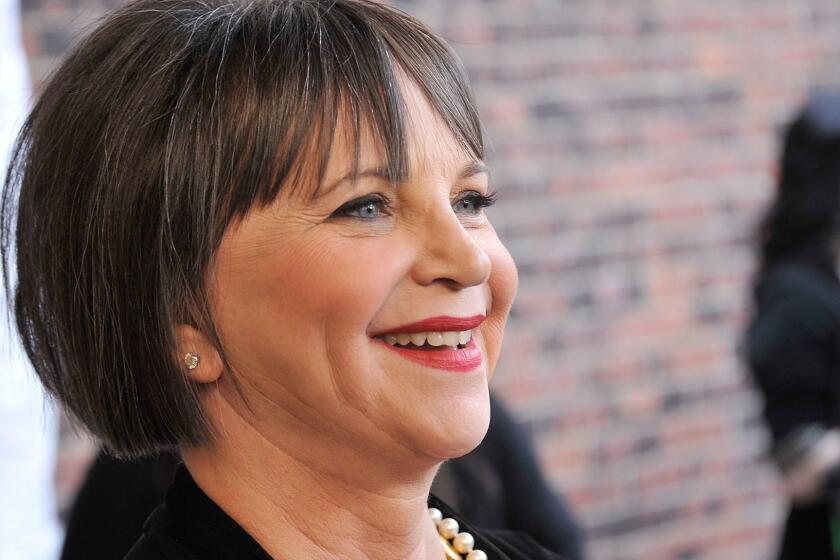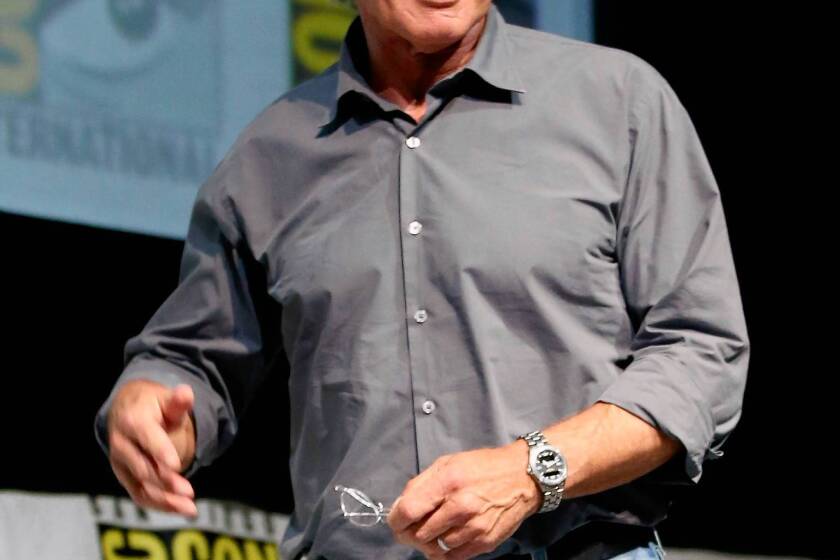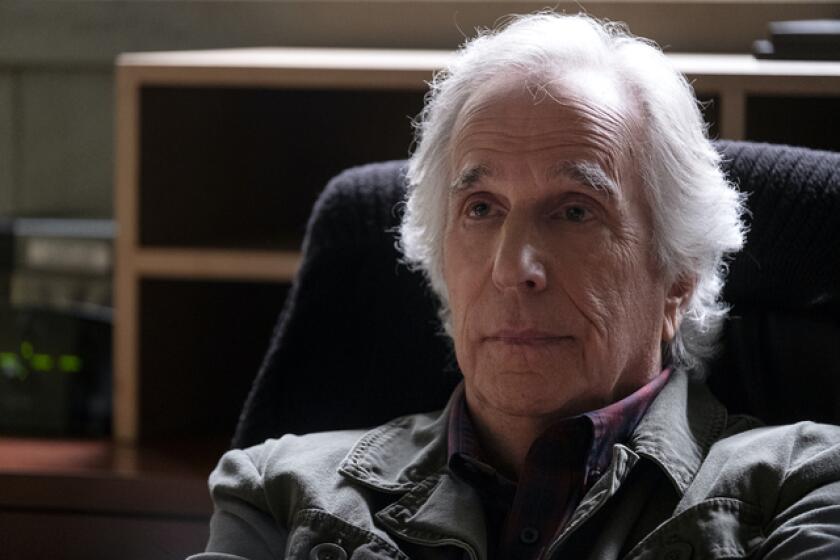
- Share via
In 1973, fresh off the flop of his first feature, “THX 1138,” Universal released George Lucas’ “American Graffiti” — a box-office sensation and cultural touchstone that almost wasn’t.
Set in Lucas’ hometown of Modesto in 1962, the ode to hot rods and rock ’n’ roll had lost the interest of United Artists, which originally developed the project, and been saved only by the intervention of Lucas’ friend and mentor, Francis Ford Coppola, who signed on as a producer. But the finished film, which featured a landmark diegetic soundtrack, a vibrant young cast and a strong vein of hopeful, Kennedy-era nostalgia, captured the imagination of audiences and redefined the teen movie.
To mark its 50th anniversary, The Times spoke with co-writer Willard Huyck, star Ron Howard and other members of the ensemble about their experience making the film, its warm reception and its lasting legacy.
Conception
When George Lucas released his first feature, “THX 1138,” in 1971, the film, based on his work as a student at USC, was a modest critical success but a commercial failure. Lucas’ mentor, director Francis Ford Coppola — who had backed “THX 1138” through his American Zoetrope production company — encouraged him to make something else.
Willard Huyck (co-writer): “THX 1138” was being shot in Los Angeles and, out of the blue, George called and asked me and [co-writer] Gloria [Katz] to meet him on set. As we’re watching a scene in which Bobby Duvall is being tortured by chrome-faced fascist cops, George turns to us and says, “You know, Francis said my next movie should be funnier. … I was thinking about doing something about the cruising phenomenon,” which we all knew about. Gloria and I had grown up in Los Angeles, and in high school that was a big deal. We’d go out at night to Bob’s Big Boy on Van Nuys Boulevard. A lot of the story is based on our friends, people we knew and their adventures, and our own experiences. For example, Gloria wanted the character of Laurie Henderson, played by Cindy Williams, to be as strong as the male characters. Laurie was based on Gloria, who was very funny and wisecracking and didn’t take s— from anybody.
I’m doing all right in school, They ain’t said I broke no rules.
Casting
On the last night of summer in 1962, high school grads Curt Henderson and Steve Bolander meet two friends, Terry “Toad” Fields and John Milner, for one last night of fun, flirting with girls and cruising Modesto’s main drag before Curt and Steve leave for college. The film follows the fellas, along with Curt’s younger sister (and Steve’s steady girlfriend), Laurie; platinum blond Debbie Dunham; and adventurous preteen Carol Morrison as they meet up at the local drive-in, head to one last sock hop and contemplate their futures, all while the viewer reexamines, and perhaps relives, a distinctive time and place in our nation’s history.
Ron Howard (Steve): When I went in for the first of six auditions, I was told it was a musical. At that point I wasn’t allowed to see the script, so it didn’t make much sense to me. Although I had played the role of Winthrop in “The Music Man” I told George, “If you need me to sing, I’m not your guy because I can’t carry a tune.” And he said, “This is a musical, but nobody has to sing.” I heard it was called “American Graffiti,” a word I had to look up because I didn’t know what the word meant. And it still didn’t really make sense when I read the literal definition. I asked George about it, and he explained the reason it’s called a musical is because it’s about rock radio. Rock radio is at the center of it, and rock radio is the American graffiti. It’s like the signature on the wall of that era. When I was eventually able to read the script, it made a helluva lot of sense to me. It’s somewhat autobiographical. George grew up in Modesto, was a hot rodder, and had a terrible car accident in high school that nearly killed him and really altered his life in a lot of ways. And it was the Vietnam era, which turned everything upside down.
Charles Martin Smith (Terry): George talked about how each of the characters except Steve, which was Ron’s character, represented him at a different point in his teenage years, which I thought was interesting. I had lived in Paris as a child, graduated from high school when I was 16, studied theater in college, performed in mainstage plays and a couple of films and TV shows, and had an agent. I decided to take a semester off to backpack through Europe, where I spent time in Stratford-Upon-Avon because I was really interested in Shakespeare and British theater. When I returned my agent said, “It’s too bad you were gone; you missed the casting for a movie that had a lot of parts for teenagers.” We went to the casting office, and he introduced me to casting director Fred Roos. I screen tested and, surprisingly, got the part. If I’d stayed in Europe another week or two, I would not have been in the movie.
Candy Clark (Debbie): I was modeling in New York and had done some film work as an extra, which I loved. I was at my agent Lynn Stalmaster’s office one day and he introduced me to Fred Roos, who introduced me to Francis Coppola while he was conducting screen tests for “The Godfather.” Fred and I developed a relationship; he wanted me to try out for a part in a movie called “Fat City.” I was just starting to crack the modeling world and didn’t want to change vocations in the middle of success. But Fred kept calling and insisting that I come to Los Angeles and try out for this part. I told him no, I just wanted to be an extra. I didn’t want to act, and learn lines, because I had no training. Finally, he convinced me, and I’m thinking to myself, “I’m getting way in over my head,” but I read for and got the part.
Mackenzie Phillips (Carol): My friends and I had put together a band, and because our parents worked in the industry, we were able to play at a hoot night, like an open mic night, at the Troubadour. The casting director Fred Roos happened to be there that night and he approached me and my mother after our set and asked if I’d like to be in a movie. And I said, “Yeah, man, that would be totally cool.” I was 12 and had no acting experience.
Clark: After “Fat City,” I was batting zeros for a year. Then my manager sent me to meet with a young director named George Lucas. I’d heard the story was set in the ’50s, so I dressed in costume. A lot of actors were there too, dressed normally, and I was so embarrassed. Finally, my name is called, I walk into an office no bigger than a closet, and I’m literally standing against the wall, staring at George Lucas, sitting behind the desk. I said, “Hi, nice to meet you,” and left. A few weeks go by, I get ahold of the script, and learn the story is set in the ’60s, which is totally different. It’s about everything we did in Fort Worth, Texas, where I grew up: cruising, drag racing, looking for action, liquor and cigarette smoking. I begged my manager to get me a second meeting, dressed like myself and talked to George like we were meeting for the first time.
Cindy Williams, who played upbeat Shirley Feeney to Penny Marshall’s wise-cracking Laverne DeFazio in the 1970s sitcom ‘Laverne & Shirley,’ has died.
Production
Although “American Graffiti” is set in Modesto, in California’s Central Valley, the film was shot in Petaluma, north of San Francisco, more than 100 miles from its place of origin. Shot in the summer of 1972, one of its most notable elements is that the entirety of the story, with the exception of two scenes, takes place at night. The cast and crew worked from 9 p.m. to sunrise, and the project was shot in 28 days.
Howard: Haskell Wexler, the visual consultant, was there almost every night that we were filming because there was a lot of very bold experimentation going on, and George was shooting at a fast pace. He was taking a lot of photographic risks using low-key light levels and depth of field to create naturalistic lighting. He didn’t want marks on the ground, or preplanned shots. He wanted a somewhat spontaneous, almost documentary approach to the film. He mostly kept the cameras away from us and captured whatever it was we were doing. Haskell was a big supporter and proponent of this visual approach. He loved the photographic experiment that “American Graffiti” represented.
Phillips: On the first day of filming, led by Francis, we stood in a circle, held hands, and shouted: “Yeah, let’s go! Let’s make this movie!” It was an interesting first-day ritual. I’m 12. I’m, like, the mascot, and I thought, “This is cool, I wonder what we’re doing.” But it was so much fun.
Smith: We were all young actors. I was 18 and excited to be working on the film because it was so well written. Toad’s a great character. He’s kind of funny and inept because he’s trying too hard, but he’s a smart guy. He has some of the best lines in the movie. When John Milner rescues him from being beaten up by the car thieves, he says, “Toad, are you all right?” And Toad says, “Yeah, I’ll die soon, and it’ll all be over.” It was a super-low-budget movie, like being in a student film. Gary Kurtz, the producer, would pick us up and drive us to [set] in his car. We didn’t have a transportation department with set drivers, or any of the other creature comforts, like chairs [to sit on during breaks between takes].
Howard: George was unlike any director I’d ever worked with because he cast us and then set us free. He wasn’t telling us what to do or guiding us, he was creating this atmosphere where we could do really nuanced, interesting scene work. There was a script, but we were given an absolute green light to improvise. Cindy Williams and I chose not to because our scenes were tight, and we liked to rehearse. We did a lot on our own to prepare. But when we started filming it just felt so real and free.
Phillips: We shot during the summer, and I lived with Gary Kurtz, the executive producer, and his family. I didn’t have a chaperone on set, and George wasn’t a hands-on director. … Working with Paul LeMat, who played John Milner, was so much fun. He was so handsome, and I was quite enamored of him. I remember the Ford ’32 Deuce Coupe, the yellow car that Paul and I rode around in. A lot of the time it was on a camera truck, and the car was rigged with lights and a camera to shoot through the windshield, and George was strapped to the side of the car directing. When I needed to take a break to use the restroom I had to literally climb in and out of the car’s windows, which were very small. Luckily, so was I.
Huyck: Gloria and I were married, and we only visited the location once because I had enlisted in the Army Reserves, to avoid being drafted to Vietnam. The filming coincided with my being stationed at Fort Bliss, Texas, so we didn’t see any actual shooting, which was really a shame, but that’s the way it was.
Stars emerge from George Lucas’ ‘American Graffiti’
Reception
“American Graffiti,” despite a title that didn’t exactly telegraph its plot, opened on Aug. 11, 1973, to widespread critical acclaim. In his review, The Times’ Charles Champlin called it “masterfully executed and profoundly affecting,” citing in particular the “powerful and complicated nostalgia” set off by the soundtrack’s 42 songs, from artists such as the Heartbeats, the Regents, Buddy Holly and Bill Haley and the Comets. The audience responded in kind: Shot on a budget of roughly $750,000, it would go on to gross $140 million worldwide and receive five Academy Award nominations including picture, director, original screenplay, editing and supporting actress for Clark.
Howard: I was 18, had been accepted to USC, and my ambitions were focused on becoming a director, and I thought this was a terrific gig. We had a really good script as a foundation. Nobody thought the story was broken. It was smart, funny, and resonated in a very truthful way to us. But we never expected the movie to be commercial or even high-profile. We thought, “This will play on the summer drive-in movie circuit and disappear.” It was a very low-budget movie, done on an absolute shoestring.
Smith: George found actors who were really talented and on their way up. And we worked really hard to try to make a good movie for him because this was the first time any of us were cast as leads in a movie. And the scenes played. Every day we’d finish the scene and think, “Wow, this went really well.” A few weeks start to go by, and you begin to think, “This movie could be really good.” At the time, my worry, and I think that of my castmates, was that George had written a good script and we’d made a really good film, but because it was low-budget and the subject matter was kids cruising around in cars, that nobody would pay attention. Ron and I had completed shooting on a western in Spain and we stayed in Europe a few weeks so I could show him Paris, since I’d lived there, and he’d never visited. We were sharing an apartment and his dad, Rance, called and read some of the trade reviews to us, which were glowing, and we were thrilled. At the same time, word was spreading overseas about the film’s success. So we cut our trip short, returned home, and by then the film had gained a lot of momentum and we were doing a lot of publicity. It was really gratifying.
Clark: Receiving an Oscar nomination was ecstasy, the happiest I’ve ever been, and it was just my second film. The studios weren’t doing the big campaigns that they do now, and the Oscars weren’t as competitive as they are now. They were modest, so anyone could run a campaign. I thought, “It’s called show business, so I’m going to invest in my business.” I placed quarter-page ads in Variety and the Hollywood Reporter for like a week or two, and it worked. I received telegrams and flowers and dressed myself and did my own hair and makeup for the event. I’d never been so patted on the back and kissed and hugged in my life. It was great. I really ate it up!
Phillips: I was living with my dad and his second wife when the film premiered, and they sent me to a Switzerland boarding school that summer to protect me. They sent me reviews and posters, and I became one of the stars of the film while I was in Switzerland. It was bizarre because I left a semi-anonymous, hippie kid with a weird family and came back famous in my own right. I had a manager, Pat McQueeney, before the film wrapped, and immediately started auditioning after I returned to L.A., booking roles in movies of the week. During an early conversation I remember she repeated my name, “Laura Phillips, Laura Phillips,” gesturing in the air as if it were inscribed on a marquee. Then she asked, “What’s your middle name?” And I said, “Mackenzie.” And she said, “Mackenzie Phillips, that’s it!” And she had my name changed in the marketing materials. I remember signing “Laura” to multiple carbon-copy contracts using different signatures, dotting the i’s with hearts and stars …an exclamation point. I was having fun.
Henry Winkler says he experienced ‘debilitating’ psychic pain when he couldn’t find work for years after playing the Fonz on ‘Happy Days.’ He says he was typecast.
Legacy
The success of “American Graffiti” spawned a nostalgia trend in movies and TV, during the 1970s and ’80s, often drawing a mythical, idealistic portrait of post-World War II America.
Ironically, it was an unsold pilot for an early version of “Happy Days,” created by Garry Marshall and featured on the ABC anthology series “Love, American Style,” that reportedly turned Lucas on to Howard — who played Richie Cunningham, a teen living in the Midwest in the 1950s. The enormous box-office success of “Graffiti” led ABC to greenlight the pilot and rush it into production. The first episode aired Jan. 15, 1974, five months after the release of “Graffiti,” and the series went on to run for a decade.
“Graffiti” also paved the way for a number of nostalgic coming-of-age films about mid-20th century American teens in the 1970s and ’80s, such as “Grease,” “The Lords of Flatbush,” “Hairspray,” “Dirty Dancing” and Eric Monte’s seminal 1975 classic “Cooley High,” which was as inspirational and poignant to Black audiences and filmmakers as “Graffiti” had been to their white counterparts.
Howard: “Graffiti” became a project and a tone that was so emulated that it’s kind of easy to forget how original it was in that moment. It dealt with nostalgia in a way that kind of lured audiences into a mythic view of that period and looked at it nostalgically. And then there was this splash of cold water at the end when the text comes up and the lives of the individual characters are explained. That has become somewhat of a trope, but at the time it was really original. To take this youth comedy and present it in a way that at the end you believe it, and then you recognize what their futures held. That was a moment of transition, a truly seismic shift.
Phillips: “American Graffiti” is the quintessential hot-rod movie. It’s a coming- of-age story that came out at the right moment. The music is a character in the film that drives the story arcs for each vignette of character and scene. It’s an honor and a privilege to have been a part of it. And I’m so grateful to George because the movie was the springboard for my career. I wasn’t thinking, “I want to be an actress, I want to be in movies” — I wanted to be a rock star — but I rode the train in that direction for a very long time. And I don’t know that it would have happened had I not been in “American Graffiti.”
More to Read
Only good movies
Get the Indie Focus newsletter, Mark Olsen's weekly guide to the world of cinema.
You may occasionally receive promotional content from the Los Angeles Times.











